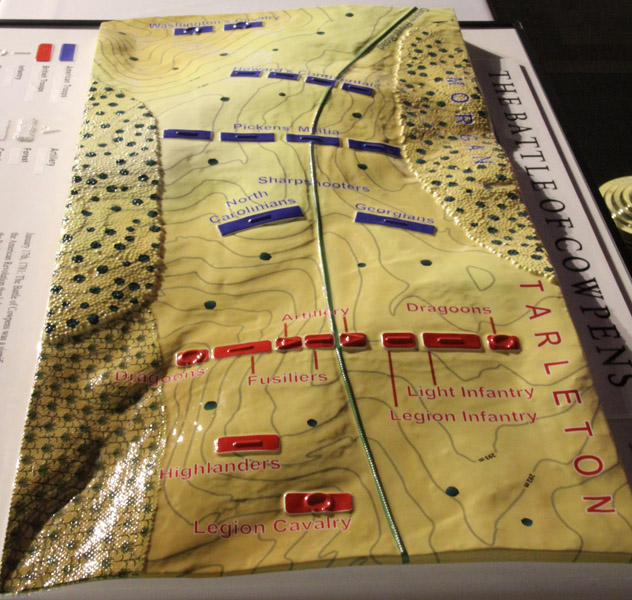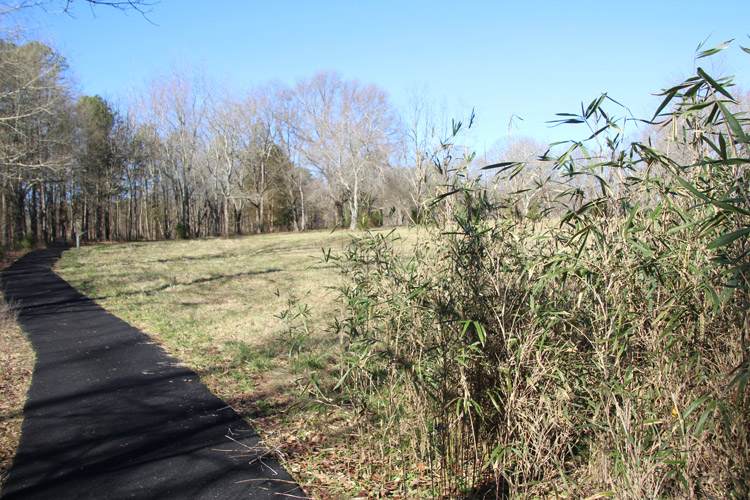Cowpens
January 17, 1781
New research has drastically revised
the traditional story of the Battle
of Cowpens. The book
"A
Devil of a Whipping: The Battle of Cowpens"
by Dr. Lawrence
Babits, using Dr. Bobby Moss's studies of pension statements and other
new sources, reflects these changes,and the virtual tour below is
intended to reflect this new
version and incorporates some suggestions from John Robertson,
who works at the site.
The South
was spared the ravages of war for much of the
Revolution. A Tory rising was quashed at Moore's Creek, and
the British
attempt to capture Charleston in 1776 also failed.
The British captured Savannah
in 1778, and in 1779 a combined American and French force failed to
retake
the city by storm. Charleston was taken in 1780
and most of the Virginia Continental Line was captured there.
Gen. Gates was sent South but was soundly defeated at Camden
in August. Only the mountain men's destruction of Ferguson's
column at King's Mountain
in October prevented Cornwallis from invading North Carolina in late
1780. Stanley Carpenter, in "Southern Gambit" argues that the
British "clear and hold" strategy was built on faulty
assumptions of Loyalist support, that Loyalists
would occupy that territory cleared of the enemy by
regulars. Nevertheless, the strategy had a chance to succeed
with patient, conservative leadership. Cornwallis,
however, was impetuous by nature, and supply difficulties made it
difficult to keep an army in one location. British policy was
based on the successful suppression of Jacobite rebellions, but in the
American South this failed to attract Loyalists because they perceived
it as too lenient while it pushed paroled patriots back into the war
because they perceived it as too harsh. Eventually it also
alienated neutrals. Seeing that patriot irregulars were
supported by the colonies further north, Cornwallis was eager to
advance into North Carolina and Virginia before South Carolina was
fully secure.
Gen. Nathaniel Greene was
appointed by George Washington to command the Southern Army.
Greene joined his army in Charlotte on December 2,
1780. Greene had only about 2,400 men to face Cornwallis'
4,000
men. Stopping Cornwallis with conventional methods would be
impossible, and feeding the entire army at one location was
impractical,
so Greene adopted a hybrid conventional/irregular strategy that would
exploit Cornwallis's personality. Greene detached Gen. Morgan
with 600 men into the direction of Ninety-Six
while Greene himself moved to Cheraw with 1,100 men. Lt. Col.
Henry
Lee was sent to assist Francis Marion in raiding British lines of
communication
in eastern South Carolina. Although Greene had divided his
already
weak force, it was positioned so that Cornwallis could not advance into
North
Carolina without exposing his flanks and rear, and it allowed Morgan to
rally militia in the backcountry.
In
response Cornwallis detached
Lt.Col. Banastre Tarleton with 1,100 men
to deal with Morgan. Tarleton's force, a light strike force,
included his Legion with
250
cavalry and no more than 271 infantry, about 50 men of the 17th Lt.
Dragoons,
263 men of the 71st Regiment, 177 men of the 7th Regiment, several
companies
of Light Infantry amounting to no more than 160 men, and two 3
pounders.
Morgan withdrew in the face of Tarleton's advance and
stripped
the
country of forage. On January 16th, Morgan stopped five miles
short
of the Broad River to make a stand. He had 300
Continentals
and
other reliable troops. Under William Washington, a cousin of
George,
were 82 Continental cavalrymen, no more than 45 state cavalrymen, and
additional
militia for a total of no more than 150 men. Militia units
had
been
arriving, and it is now thought that Morgan's force totaled around
2,000 men, which is roughly the number that Tarleton thought that he
had faced.
The night before the battle, Morgan
went to the soldiers'
camps and told his men about the battle plan, and he reminded them of
Tarleton's massacres and that if they ran, they would be
trapped at
the Broad River. On the morning of January 17, 1781, Morgan's
men had
a hearty breakfast and awaited the enemy. Tarleton feared
that Morgan
would slip away, so he awakened his men at two o'clock in the morning
to
begin the four mile march to Cowpens. At 6:45, Tarleton's
cavalry
screen reached the clearing at Cowpens.


Books on the battle often include
schematic maps that do not accurately represent the terrain.
The NPS visitors center includes this great relief map.
The round green dots represent woods that protected both
American flanks. The other green symbols are canebreaks, a
native form of bamboo.

British Deploy and
Attack
| Tarleton and his men reached this
clearing and saw an
American force deployed in front of them. This is a view from
the
(British) left
side of the clearing called Hannah's Cowpens. In the flat
land in
the foreground there was low swampy ground known as 'the
rivulet',
an area which is now more firm. American
riflemen from Georgia and the Carolinas served as a skirmish
line
behind
it further uphill, but also extended toward the woods on their right.
These are the faint gray woods in the background.
Further
back, behind the small hill on the left of the
picture stood the South Carolina militiamen under Gen. Pickens.
In
the woods on the far left of the picture, the flank was protected by a
ravine with a stream and canebreaks. On the other
flank near
the woods, and protecting that flank,
were two heads of a stream also with canebreaks. The militia
line
was
anchored on each of these obstacles, and was positioned behind the hill
because
troops firing downhill tend to fire over the enemy's heads.
Behind the militiamen, not visible
to the British, but
on or beyond a slightly higher extension of the ridge near were it
moves back, were the Continentals and Virginia militia under Lt. Col.
John
Howard. At the far end of the clearing, and hidden the
hill was the cavalry under William Washington.
Tarleton deployed to attack with each
flank protected by 50 cavalrymen. The infantry from
right to left were the Lt. Infantry, the Legion Infantry, and the 7th
Regiment.
Two 3 pounders were deployed on either side of the 7th.
Further
to the left, and somewhat behind, was the 71st Regiment. In
reserve
were the 200 men of the Legion cavalry.
|

Canebreak
|

View From Skirmish Line
The British advanced toward the
American skirmishers,
who after firing a few shots withdrew. They would join the
militia line.

Militia Line
Canebrakes protected both flanks of the
American
militia line. Hayes' Bn., one of the four
units of Pickens command, had advanced ahead of the militia
line on the left side of the road. The
skirmishers
withdrew around this
unit and to the flanks of Pickens' line, and Hayes fell back
into
line.
The
British infantry continued the advance and were met
with a volley at under 100 yards. Despite their high losses,
the British
kept coming, and the militiamen fell back in confusion behind the
Continentals.
The Virginia militia units flanking the Continentals had
temporarily
withdrawn en echelon to allow the passage of the first line militiamen.

View from Continental Line
of John Eager Howard
Morgan moved to rally Pickens' men.
Skirmishers
from the front line had withdrawn to Howard's left flank.
These men
did not have bayonets, and as the British continued to advance, their
cavalry rode over the skirmishers and into Pickens'
militia. They came under
fire from the Continental line. William Washington's
cavalry had been stationed in a low area, probably in the area west of
the trail from the visitors center. Their position had
been concealed from the British, but cannonballs
rolled into
their position. Washington came out from hiding with
half of his cavalry, smashed into Ogilvie's British cavalrymen, and
forced them from
the field.
Despite having his flanking cavalry
routed, Tarleton continued the advance on the Continental line,
possibly not seeing most or all the line and simply pursuing the
militiamen. The British advanced and exchanged several
volleys
with the Continentals. On the British left, the 71st Regiment
was brought
up to flank the American right.
When the
71st Regiment moved against the American right, Howard ordered
the flank refused. This created confusion, and the whole line
began
to retreat. Seeing this, Morgan selected a new line and had
his troops
face about and fire. Near the Washington Lt Infantry Monument
is where the Continentals
were positioned, possibly lying on the ground. As the British
rushed toward them, the Continentals leveled a devastated fire on the
disorganized British. Washington's cavalry had moved to the
American
right to protect the flank and rear of the militia from
the 71st
Regiment and now moved around the American right to attack the
rear of the British line. While
Washington smashed into the flanking British cavalry and moved
into the British rear, Howard's line charged.
Hundreds of
British troops were encircled, and they threw down their weapons to
surrender.
Tarleton rushed to his Legion cavalry
and ordered them
to attack and save the day, but they fled the field. Tarleton
instead
counterattacked with 54 officers and men, but after some success, he
was repulsed.
The Continentals continued the pursuit and captured the two 3
pounders,
their crews fighting to the death.
The battle
is a tactical
masterpiece admired to this
day. The American regulars suffered only 12 killed and 60
wounded,
but also counting the militia would probably double the
figure.
The
British suffered 100 killed, 229 wounded, and 600 captured.
Only
the
200 Legion cavalrymen escaped. Strategically, the British
were
significantly knocked down to size, making the conquest of the South
much more difficult. Compounding the loss in numbers, those
lost had been from the British light strike force, also used
for reconnaisance. Cornwallis pursued Morgan but failed to
cut
off his
retreat. He believed that if he didn't advance into North
Carolina and Virginia, he couldn't hold South Carolina and Georgia.
The British pursuit had been slow, covering only 22 miles in
seven days compared to the patriots marching 100 miles in five days.
Cornwallis decided that now was the time for drastic action,
so he burned his baggage, resulting in 250
desertions, and recklessly pursued Morgan and Greene
to the Dan River in Virginia. Hearing that Cornwallis had
burned his baggage, Greene decalred, "He is ours!" As
Cornwallis weakened, Greene got
stronger.
Down from 4,000 men to less than 2,000, Cornwallis
fought at Guilford
Courthouse, and after the battle Cornwallis was
so weak he had no hope of holding on
to North Carolina. Instead, he fell back to
Wilmington, then advanced
into Virginia. There, in October, he was forced to surrender
at
Yorktown.
Back
to Revolutionary War Virtual
Battlefield Tours






